Curated Playlist: Dutch Illustrated Biblical Youth Television
By Grietje Hoogland (University of Amsterdam)
In Dutch television history, different Christian beliefs are strongly represented. Dutch television started with four large broadcasting associations in 1951, which represented the four ideological ‘pillars’ that divided the Dutch society. Two of these pillars were religious: the Catholic pillar was represented by the KRO and the Protestant pillar by the NCRV.[1] The VARA and AVRO represented the socialist and liberal pillars. There were more broadcasting associations which were smaller in memberships and airing time, such as the reformed VPRO, the Catholic collaboration of churches in CVK/RKK/IKON/IKOR and later the Evangelical EO.[2] This means that over the years, a lot of biblical television content has been made, for adults, but also for children. My Ph.D. research, titled: “Illustration and animation in Dutch public youth television, 1951-1996: Media technological, financial and cultural influences forming a professional cultural field”, focuses on the history and development of Dutch illustrated and animated youth television. For this research, I collected youth programs to be able to analyse them and place them into historical context. Among these programs, illustrated biblical children’s programs take up a large portion and can therefore be defined as a sub genre.
In the 1960s, the illustrations for all television programs were made mostly by freelance book illustrators, and from the end of the 1960s on more and more by illustrators who were employed by the facility department of the NTS/NOS/NOB, which was the overarching broadcasting association in which all broadcasting associations worked together. These illustrators were versatile artists from art academies who had a fulltime job illustrating, animating and designing everything from logos and leaders to weather charts and youth programs, for all broadcasting associations.
Biblical illustrations
This curated playlist shows some of the illustrated biblical youth television programs categorised by broadcasting association, and per association in chronological order. If we were to place all programs in chronological order instead, without dividing them into broadcasters, this would show us that black and white television and colour television alternate a bit, even though it would have made sense if the first couple of programs were in black and white and the rest in colour. Simply put, the reason for this is that colour television was introduced in 1967, but many people still had a black and white television set.[3] Therefore, illustrations that were made in colour were made with black and white in mind, but black and white illustrations were still made as well.
What a chronological order also would not show, is a linear development from traditional to artistic depictions of the Bible, even though there clearly are traditional and artistic interpretations of biblical stories in this collection. I call illustrations traditional when they resemble more classical depictions of biblical stories: long robes, classical compositions etc. Artistic illustrations take a different approach, for instance a freer illustrative style or different ways of depicting the subject. Programs can also have a more artistic drawing style but still show quite traditional images. As we will see, how traditional or artistic a program is does not depend on the period of time, but rather on the broadcasting association. We will see shortly that the smaller IKON and EO are more conservative, while the larger KRO and NCRV are more progressive in the way they introduce the Bible to children, with regards to narrative as well as illustrations. Often, the illustrations reflect the nature of the program and the identity of the broadcasting association.
Below every program image the ResourceID is mentioned: with this ResourceID you can find that particular episode in the CLARIAH Media Suite. A link to the video is added as well, although a login is required.
IKOR, IKON, CVK, RKK
The IKOR was the interdenominational consultation on radio matters (Interkerkelijk Overleg inzake Radioaangelegenheden), which continued on television when this medium was introduced in 1951.[4] They merged with the CvK (Convent of churches) into IKON in 1976. The RKK was the Roman Catholic Church Association. They were smaller broadcasting associations with less airing time than the four largest associations VARA, AVRO, KRO and NCRV. Therefore, and also because of their shared goal, which was mainly ensuring that there is Catholic content on television, they often collaborated on programs.
The three oldest biblical children’s programs are all made by IKOR, CVK and RKK. They are usually traditional in their narrative: tellings of the Bible as they are, which fits their mission and is also to be expected in a period of finding out the possibilities of this new medium. The illustrations usually fit the narrative and are often, but not always traditional as well, as you will see in the examples below.
Logboek (CVK/IKOR/RKK, 1959-1964)
Logboek is traditional in content as well as narrative. The illustrations are made by Otto Dicke, who was a freelance illustrator, Henk Vermolen and Johan Volkerijk (both NTS illustrators). These illustrations fit the content and narrative and are traditionally made, both in depiction of the subjects as well as drawing style.
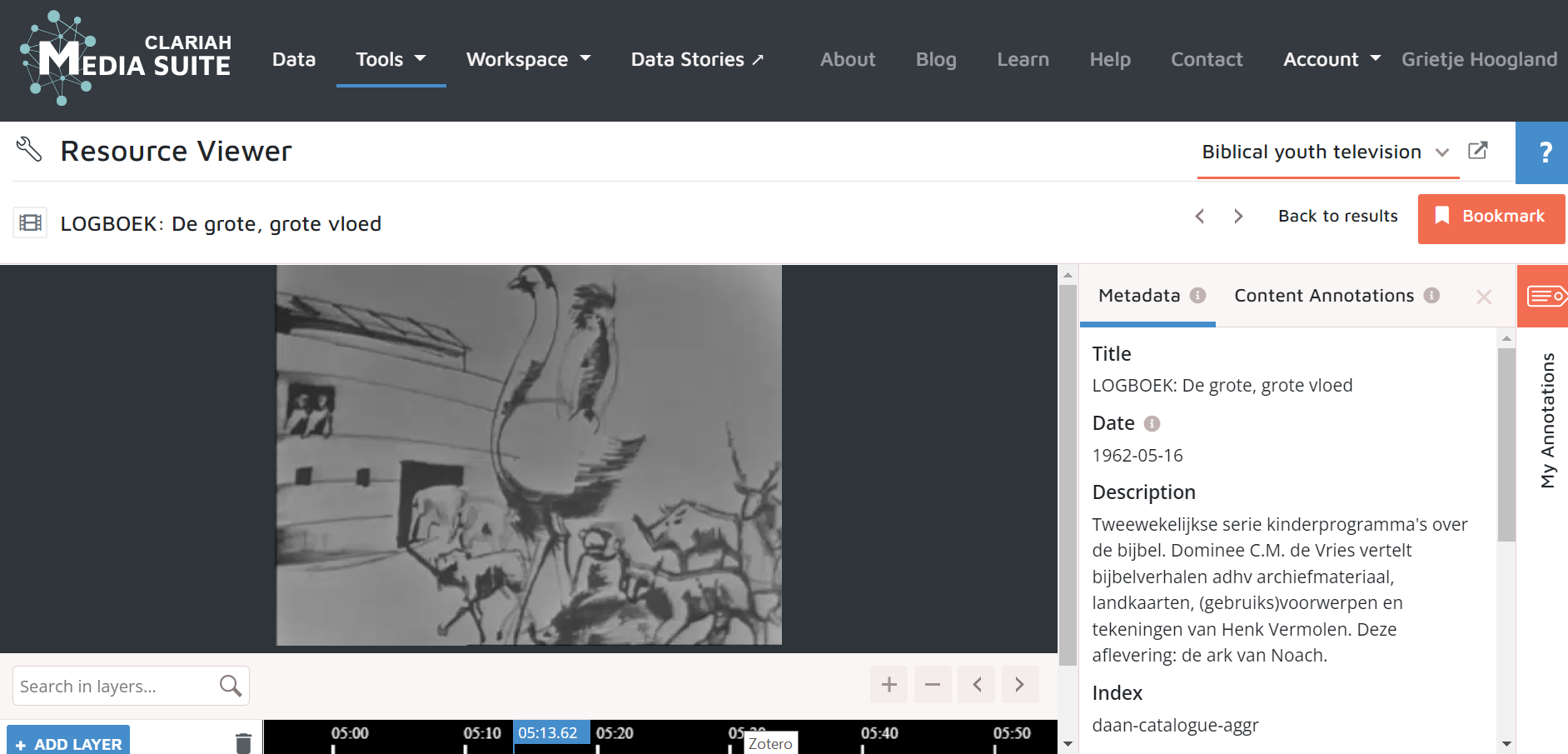
ResourceID: 2101608060045206631, Link to video (login required)
Woord voor Woord (IKON/IKOR/RKK, 1965-1976)
Woord voor Woord started as a traditional program in 1965, presented and narrated by Cecilia Lichtveld. Her wording and style is very close to the Bible, but slightly adapted to the young audience, with simpler words and a soft and friendly tone as if she is reading a children’s book. When Aart Staartjes took over in 1967, the program became more progressive, especially in how the biblical stories were worded. Staartjes for instance spoke of biblical personae who quarrelled as if he was talking about regular children who quarrelled. Although at first not everyone accepted this way of talking about a holy book, it soon became clear that children responded well to the program.
The illustrations were made by freelancer Bert Bouman at first, in the traditional style in the image below. In 1970, when Staartjes had been the presenter for a couple of years already, Friso Henstra took over the illustration. His illustrations were traditional in composition but artistically drawn.
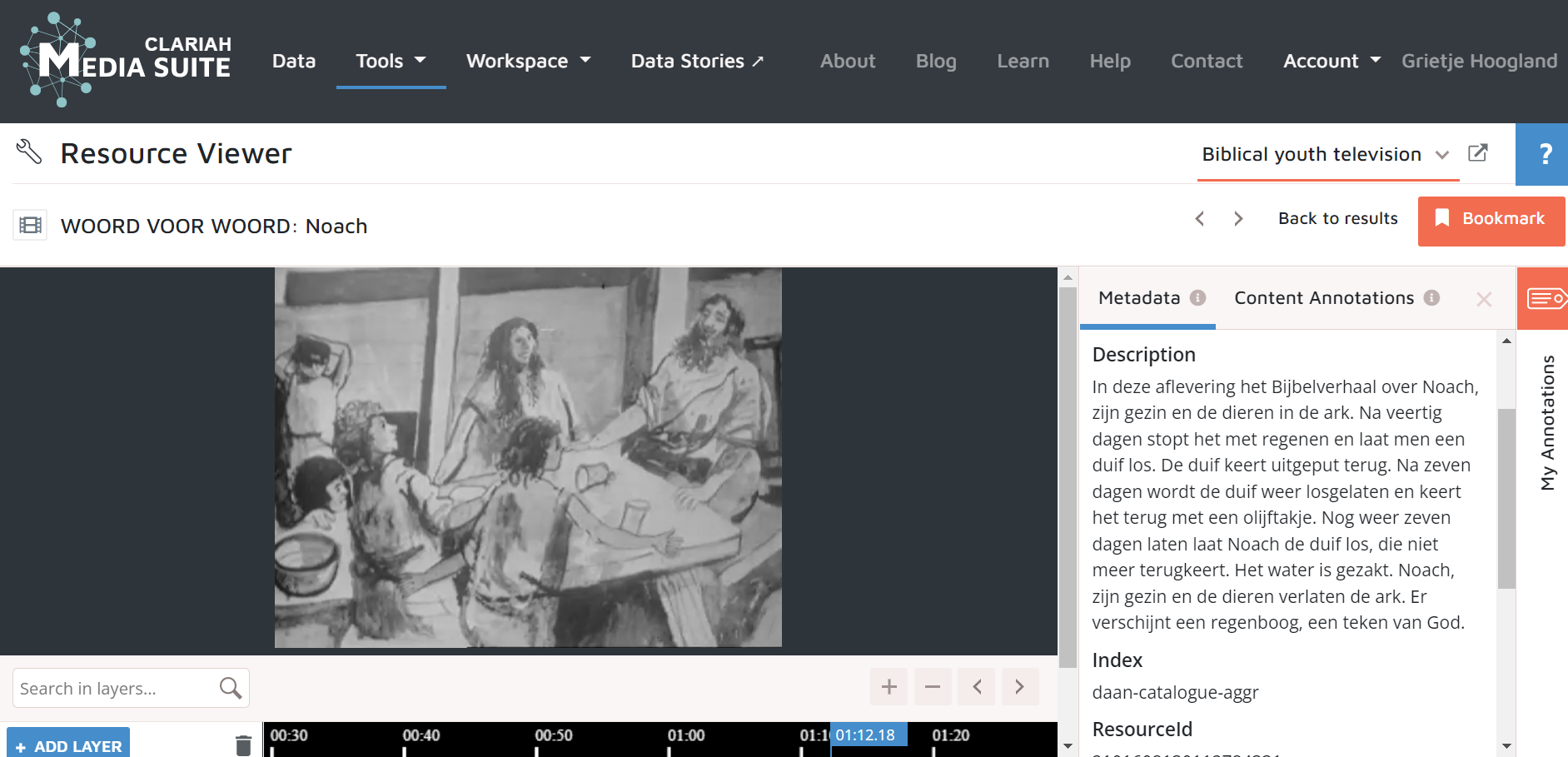
ResourceID: 2101608130112784331, Link to video (login required)
In die dagen (CVK/IKOR/RKK, 1967)
In die dagen is traditional in content and narration, but artistically illustrated. It is also the first colour program on Dutch television.”[5] This program in six episodes about the prophet Isaiah, was illustrated by writer and book illustrator Noni Lichtveld (freelance). Lichtveld used many slides and layers, to give the program movement and depth, and because of that, it is quite dynamic. The compositions are quite traditional still, but the original use of materials and textures makes it quite unique.
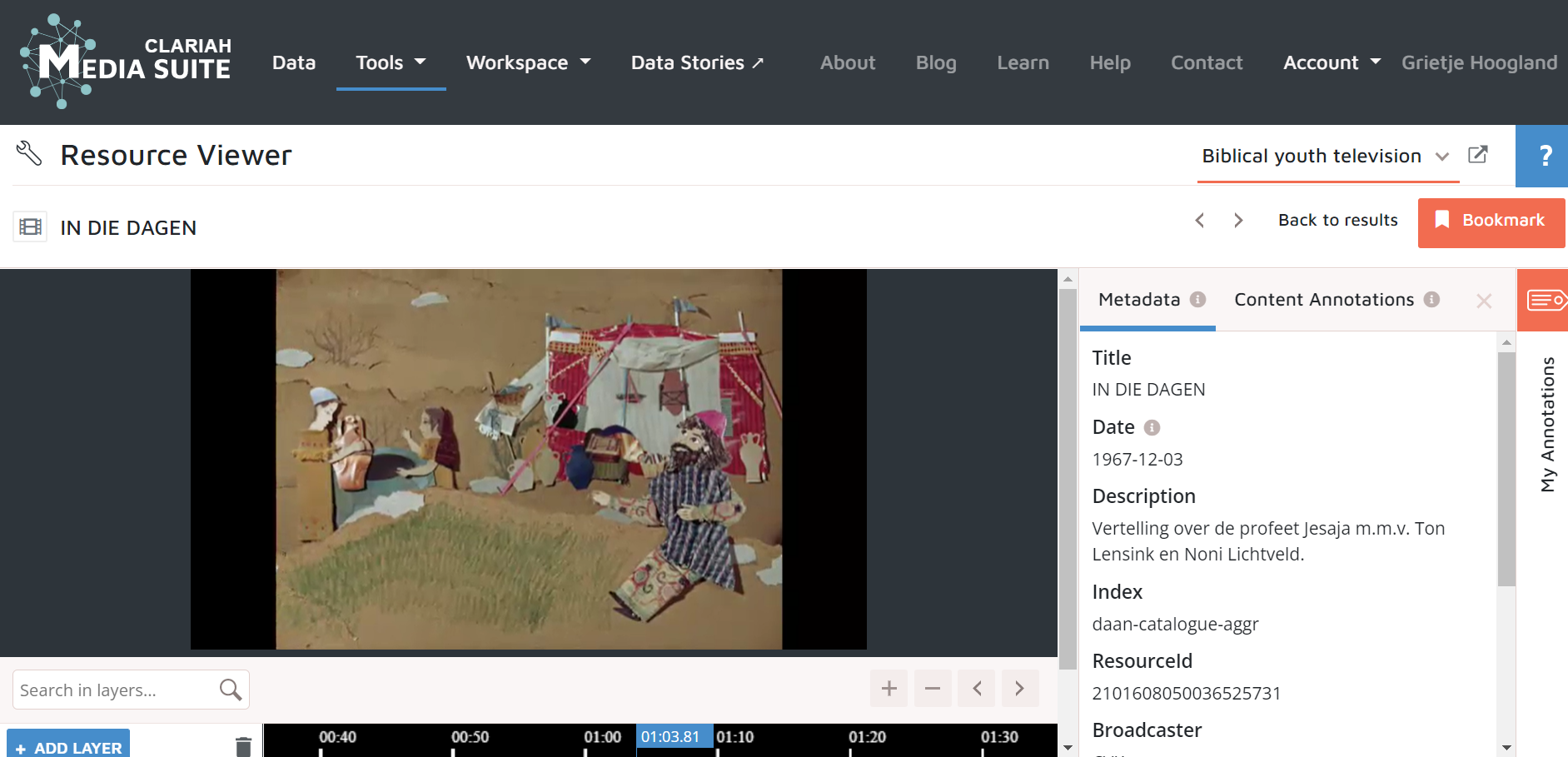
ResourceID: 2101608050036525731, Link to video (login required)
Kijk, de Bijbel (part of Studio op Stelten, IKON/RKK, 1994-1995)
A much later program by IKON/RKK is Kijk, de Bijbel. The title Kijk, de Bijbel is a reference to the Kijkbijbel (the viewing Bible), a bible with illustrations made by Kees de Kort. This Bible was published in 1992 and had the same illustrations. The material was not new however: Kees de Kort already illustrated small books with separate Bible stories in the 1960s, the bundled version of which became the 1992 Kijkbijbel. IKON/RKK reused the books and/or original illustrations by de Kort for their program, and as we will see when we arrive at NCRV, they were not the first ones to do so.
As one can imagine since the stories originated in the 1960s, they are quite traditional, even in the 1994 television series, although this 1994 retelling is done in simplified wording for children. The illustrations are traditional in composition and use of colour as well.

ResourceID: 2101608060045797931, Link to video (login required)
KRO
In the beginning The Catholic KRO did not air that many biblical programs on Dutch television, because there was not much airing time to divide among all broadcasting associations, so the programs they made needed to be for everyone.[6] In 1953, Father Leopold Verhagen gave a speech on television which was far less serious than that of other Fathers, which turned out to be a success. From 1961, H van Doorn became the new chair of the KRO, after Father J. Kors. Van Doorn was the first director who was not a Father, and he was much freer in his interpretations and wording of the Bible. This resulted in freer programs, which continued in the 1970s and 1980s. Pluriformity, diverse reporting and relativisation were more important for the KRO than direct representations of the Bible and the Catholic religion.
This freer approach to programs is visible in the biblical children’s programs, although these programs are all actual retellings of biblical stories. But the illustrations of these biblical programs were allowed to be more artistic, and they show human emotions more.
De wijzen uit het oosten (KRO, 1968)
De wijzen uit het oosten was made in 1986 by freelancer Noni Lichtveld, who also made In die dagen for CVK/IKOR/RKK. It is very similar, both in content and narration as well as artistic illustrative style, with Lichtveld’s characteristic movable illustrations.
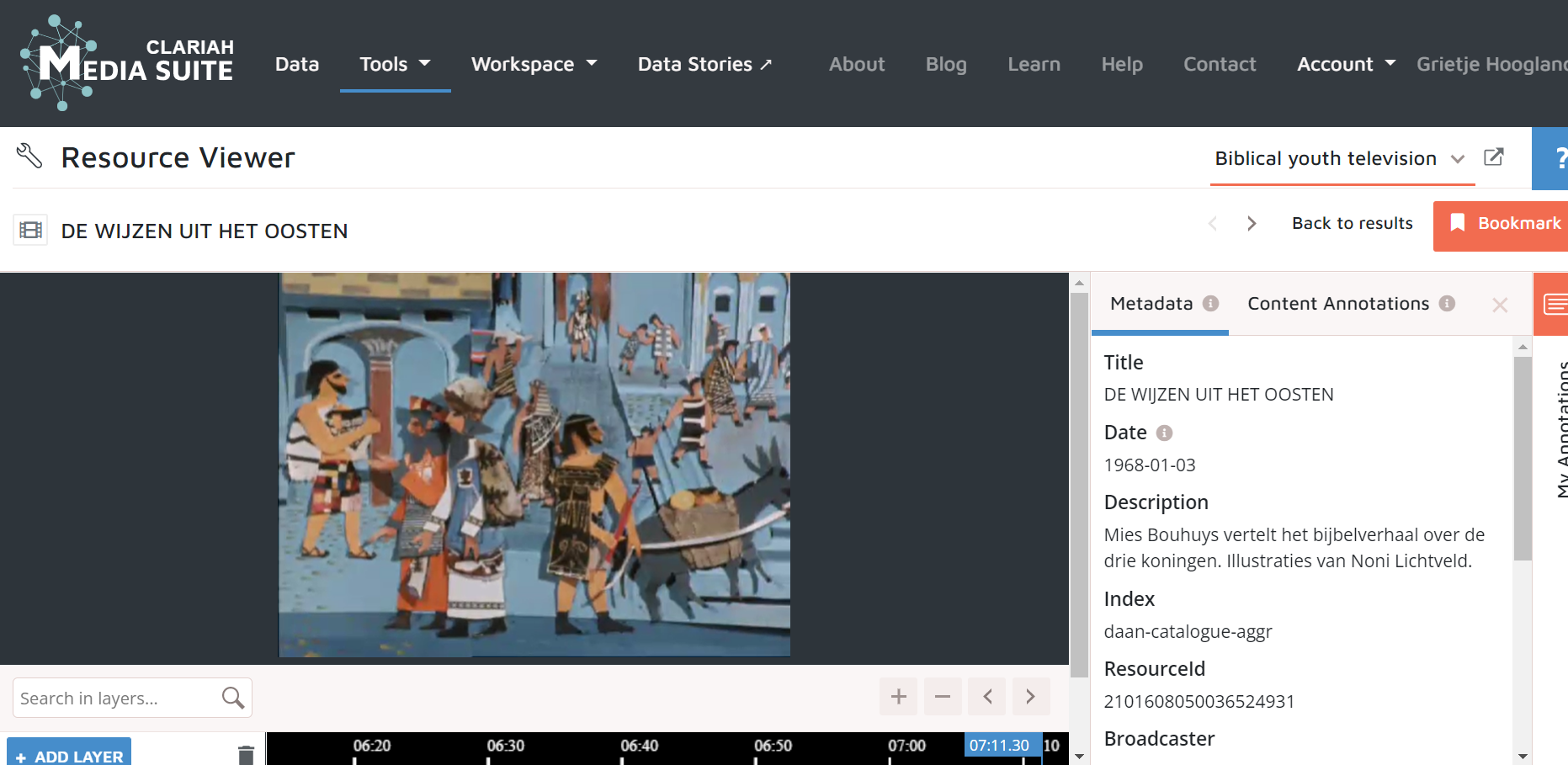
ResourceID: 2101608050036524931, Link to video (login required)
Oude Testament: Abraham (KRO/STV, 1984)
In the 1980s, two Old Testament programs were made by the KRO, the first about Abraham. The illustrations of this program are made by NOS illustrator Hans de Cocq, who has an artistic approach to the subject matter. He uses mixed media and creates depth and striking close ups of faces and hands to convey the human side of the story.
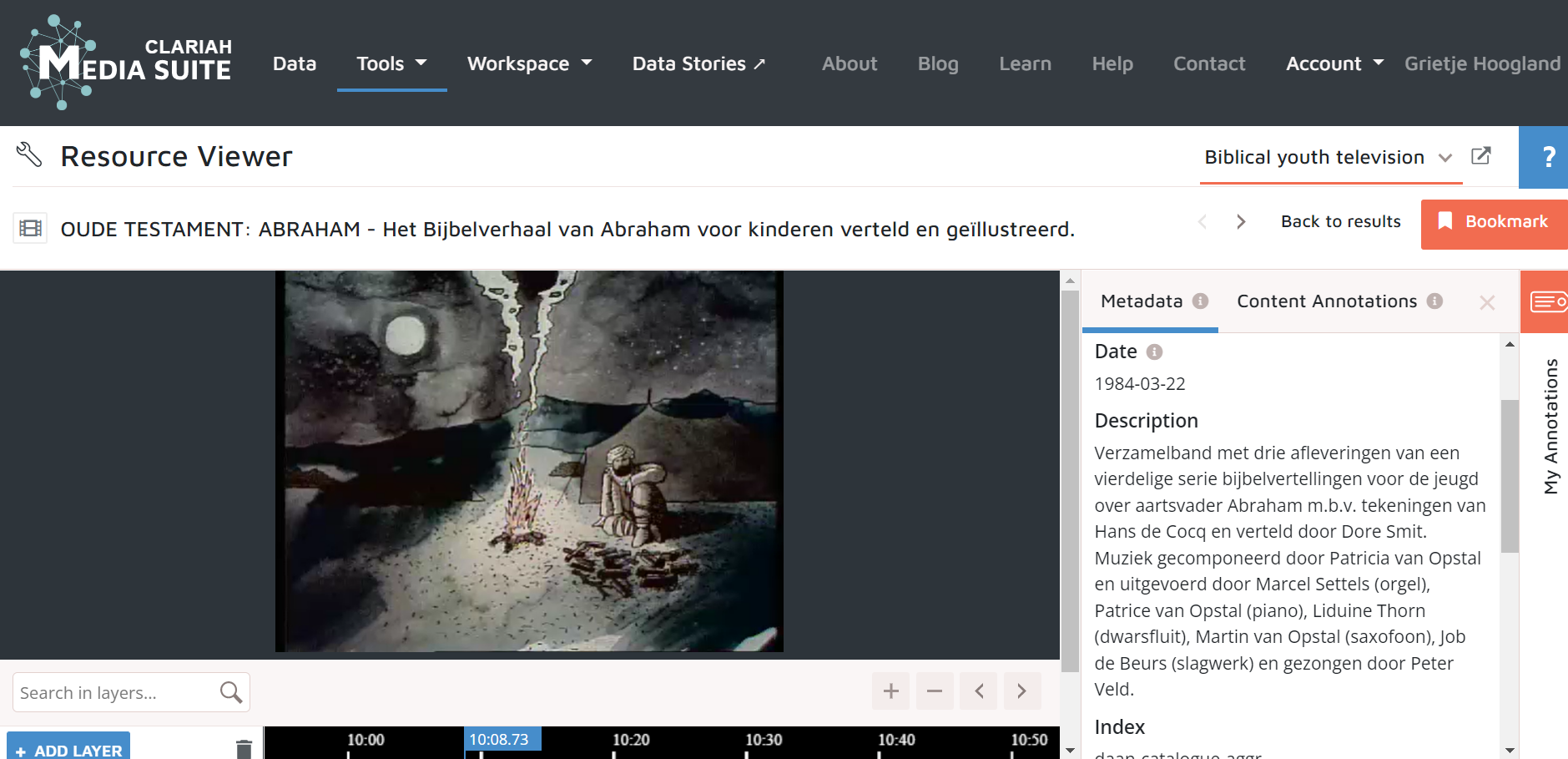
ResourceID: 2101608050037013631, Link to video (login required)
Oude Testament: Esau en Jakob (KRO/STV, 1986)
The second Old Testament program by KRO and STV is about Esau and Jakob and is artistically illustrated by NOS illustrator Henk Vermolen. He uses a bright but reduced colour palette with a unique drawing style. He also used cut-outs and layered them to bring depth to the illustrations. Just like De Cocq, Vermolen shows the emotions of the characters, which fits the priorities of the KRO.

ResourceID: 2101608050039659231, Link to video (login required)
NCRV
Similar to the KRO, the NCRV did not limit itself to mainly Christian television programmes. In the 1950s, the broadcasting association excelled at informative children’s productions and drama series. In the 1960s the NCRV noticed that attempts to convert people through television were not successful, so they focused on high quality television programs instead, but with a religious morale. In the 1970s the NCRV was a bit afraid of losing members to the new association EO, so they strengthened their image in the 1970s and 1980s by leaning on existing successes. Except for a few distinctly christian programs, there is not much room for religion in their programming.[7] Interestingly enough, there still are a couple of biblical children’s programs, especially in the 1980s, but the storylines are more progressive and the illustrations are artistically made.
Kijkkast (NCRV, 1968)
With IKON/RKK’s Studio op Stelten from 1994 we saw the Kijkbijbel by Kees de Kort, but here we see the first program that used De Kort’s illustrations: Kijkkast. These popular small books with separate biblical stories were highly popular and were found in the homes of many families. The NCRV narrated these stories in 1968 and showed De Kort’s traditional illustrations before the camera. The narration of these stories are more traditionally done than the 1994 version by IKON/RKK, with more formal language and biblical songs in between.
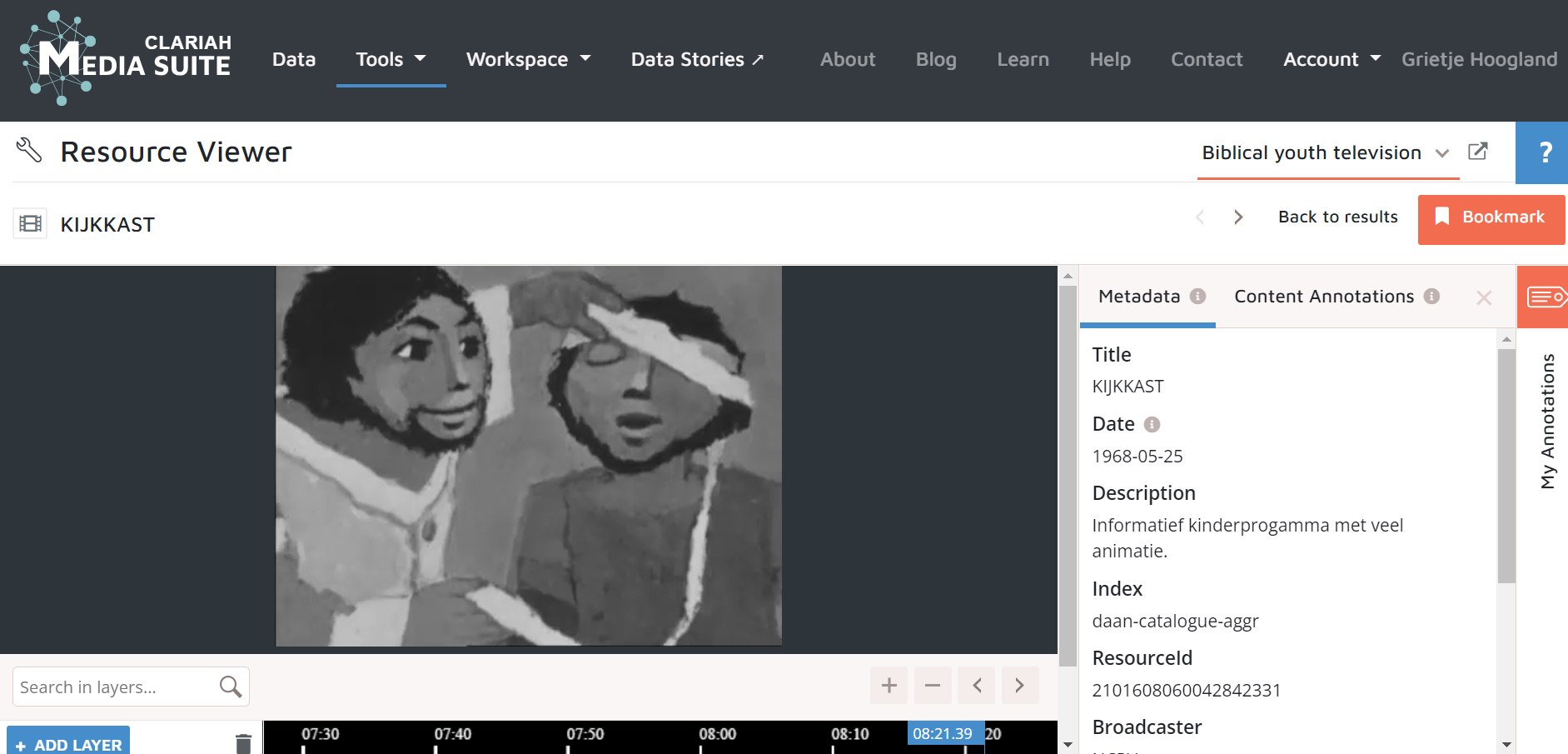
ResourceID: 2101608060042842331, Link to video (login required)
Bijbelverhalen (NCRV, 1980)
After a hiatus in biblical stories in the 1970s, the NCRV picks up biblical storytelling again in the 1980s. Bijbelverhalen (Bible stories) is a series of biblical stories which all have the word ‘koning’ (king) in the title. The stories are narrated in a comprehensible way that fits the target audience. Several NOS illustrators illustrated one or two episodes: Arie Teunissen, Hans de Cocq, Ton Holst and Monaa van Vlijmen. The latter illustrated the episode below, in which we see a very dynamic and artistic interpretation of the story of King Herod.
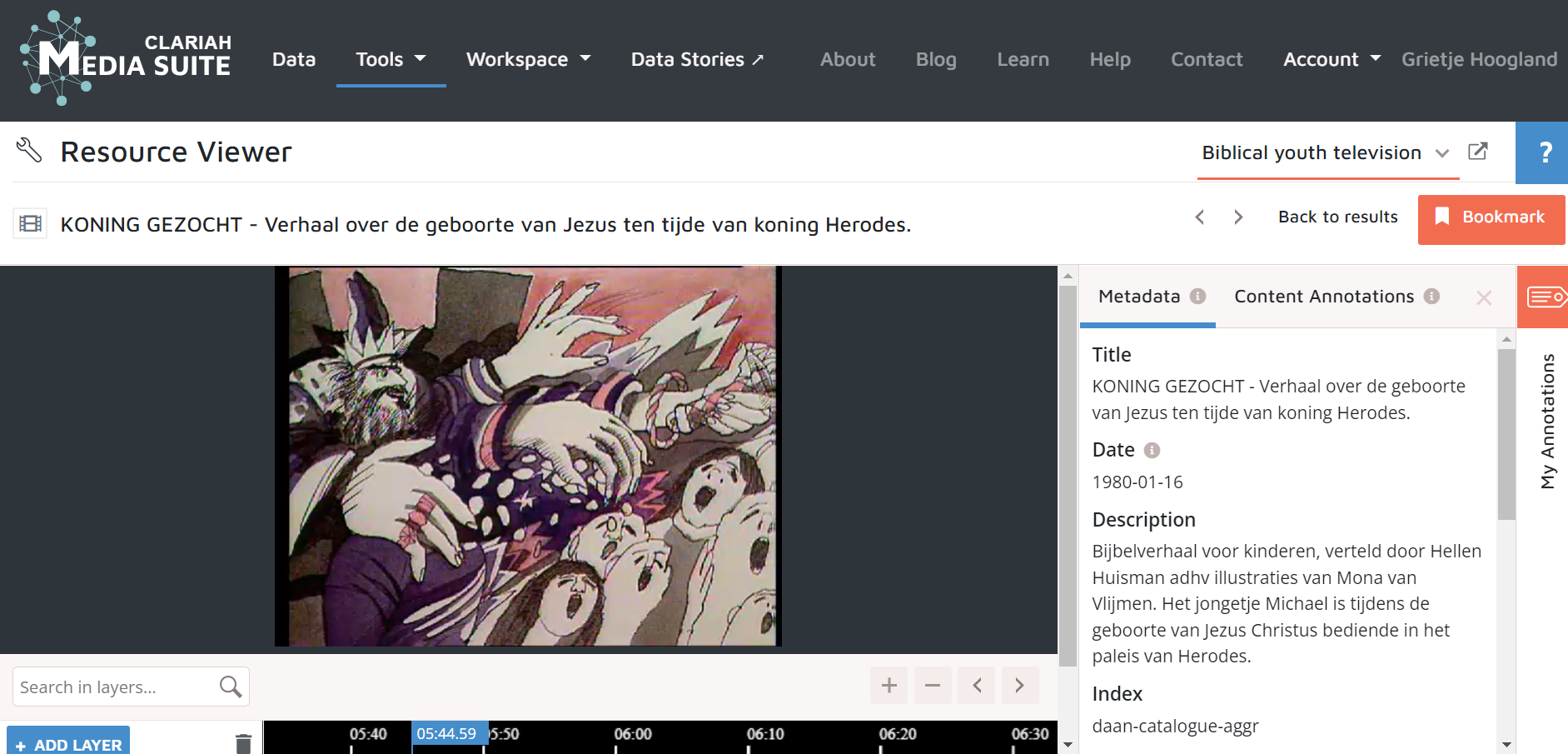
ResourceID: 2101608050037061031, Link to video (login required)
Kleine Isar (NCRV, 1981)
A special project is Kleine Isar, a story about a child king called Isar, who hears about another child king called Jesus and goes on a journey to meet him. The 18 10-minute episodes (a total length of two feature films) are fully illustrated by Henk Vermolen, who made miniature sets with upright cut out figures, which he painted in great detail in his own artistic style. The narrative is progressive in using the perspective of a fictional child king to give children the opportunity to relate to the stories in the Bible. The equally, or maybe even more progressive illustrations give the world that Isar learns about an almost wondrous, fairytale-like atmosphere.
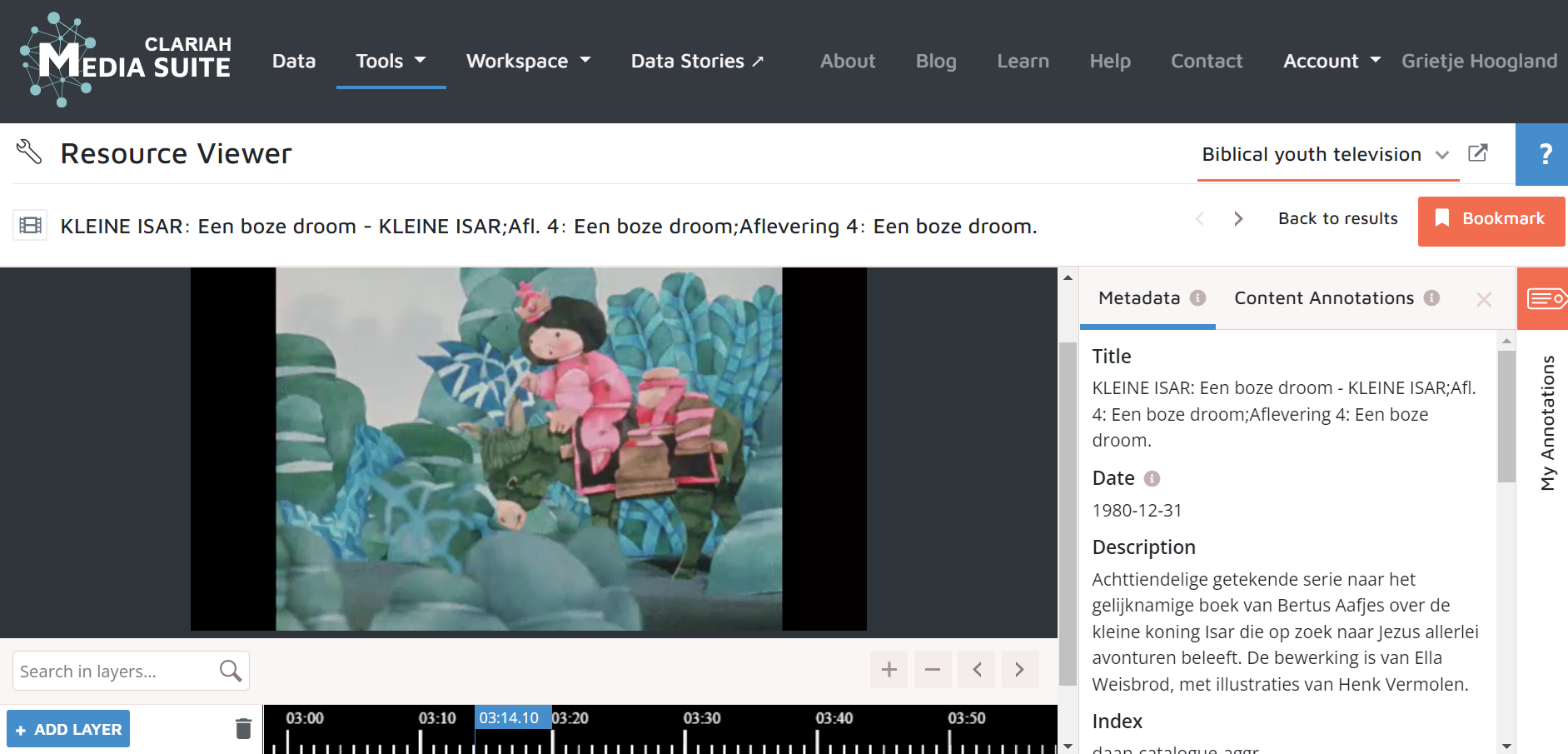
ResourceID: 2101608040029303631, Link to video (login required)
De kinderen uit de Bijbel (NCRV, 1984)
De kinderen uit de Bijbel (The children from the Bible) is similar to Bijbelverhalen, but instead of focusing on kings, this series focuses on children in the Bible. The stories are told from their point of view, which helps the children who watch this series to connect to the stories in the Bible, which counts as a progressive way of storytelling. Again several NOS illustrators illustrated one or two programs: Monaa van Vlijmen, Hans de Cocq and Johan Volkerijk, who illustrated the story of Simson in the image below. This particular example is a bit more traditional in its depiction, but very free in composition and drawing style.

ResourceID: 2101608050037189331, Link to video (login required)
EO
When the NCRV moved away from biblical content at the beginning of the 1970s, the evangelical EO was founded to fill this gap. Their main mission was to get the story of God across in all layers of society.[8] The EO has a tendency to stay as close to the Bible as possible, and therefore over all shows traditional interpretations of the Bible. But from the second half of the 1980s we can see that the EO started to understand the reason that the NCRV backed away from this method: not everyone is interested in this direct content. Their content remains very biblical and moralising, but they move towards a fresher visual appeal.
Zomaar een vrouw (EO, 1979)
One thing that is very interesting about Zomaar een vrouw (just a woman), about the women in the Bible, is that this program, although most likely made in 1979, is basically illustrated in black and white. Unfortunately it is not possible to watch the program in the CLARIAH Media Suite, but the original drawings, that reside in the archive of Sound and Vision in the collection of NOS illustrator Jos van Grieken, show portraits of women from the Bible drawn in black, white and brown. Van Grieken was a bit older than the other illustrators, and had a more traditional approach to his illustration. We cannot see the program, but knowing that the EO generally has a traditional and missionary approach, it is very likely that the traditional illustrations fit the content.
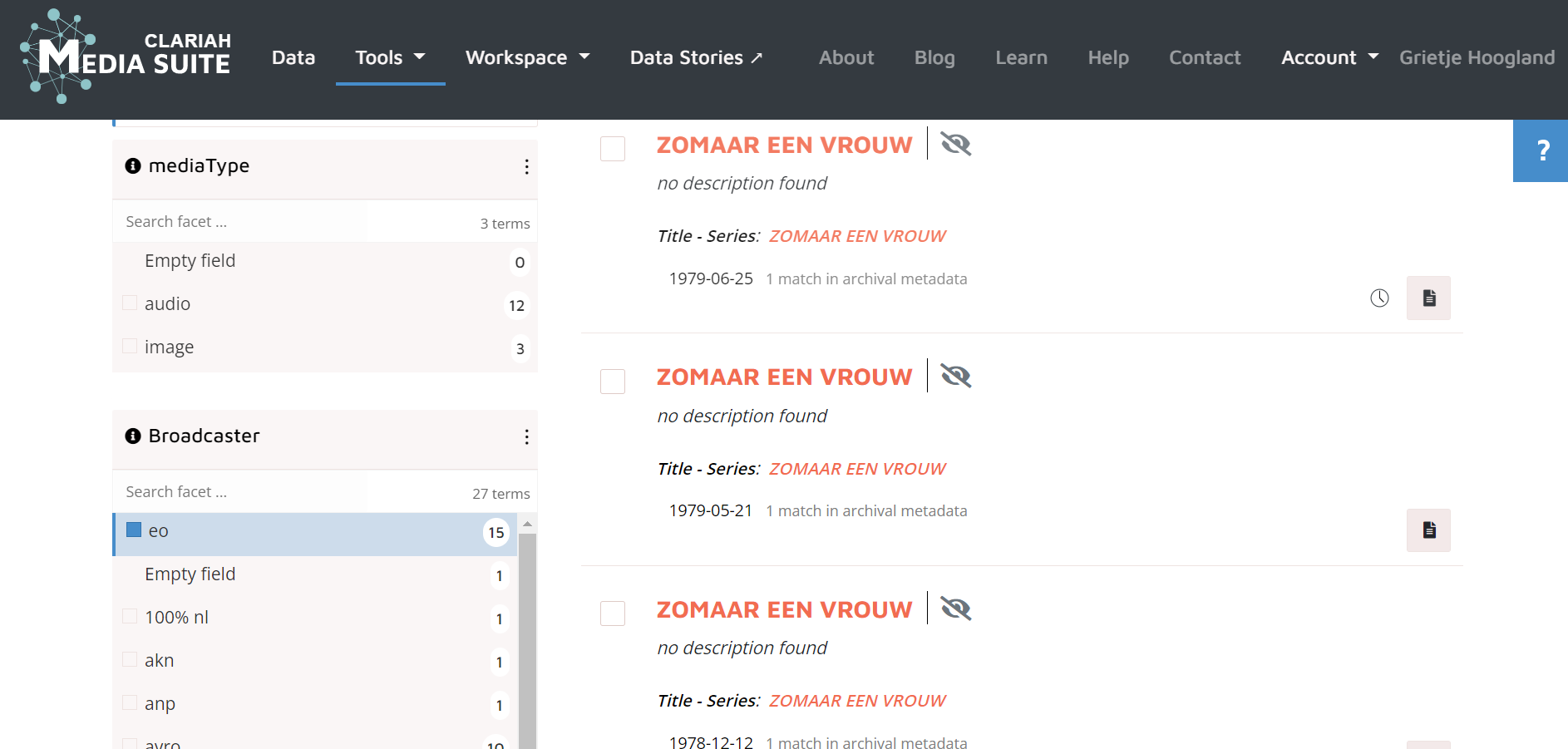
ResourceID of the oldest one: 2101608160143862531, Link to video (login required)
Kinderkrant (EO, 1972-1993)
EO’s Kinderkrant was a program that ran for 21 years, which is a very long time, especially for a children’s program. This magazine had a couple of recurring items that also ran for years on end. Among them were stories from the Bible, illustrated by freelancer Ben Horsthuis. The stories are traditional, and Horsthuis’ illustrations are also traditional in every possible sense: composition, use of colour, depiction of people and scenes and drawing / painting style, which is very unexpected for the 1980s, considering the programs that the KRO and NCRV were making, but fitting to the mission of the EO.
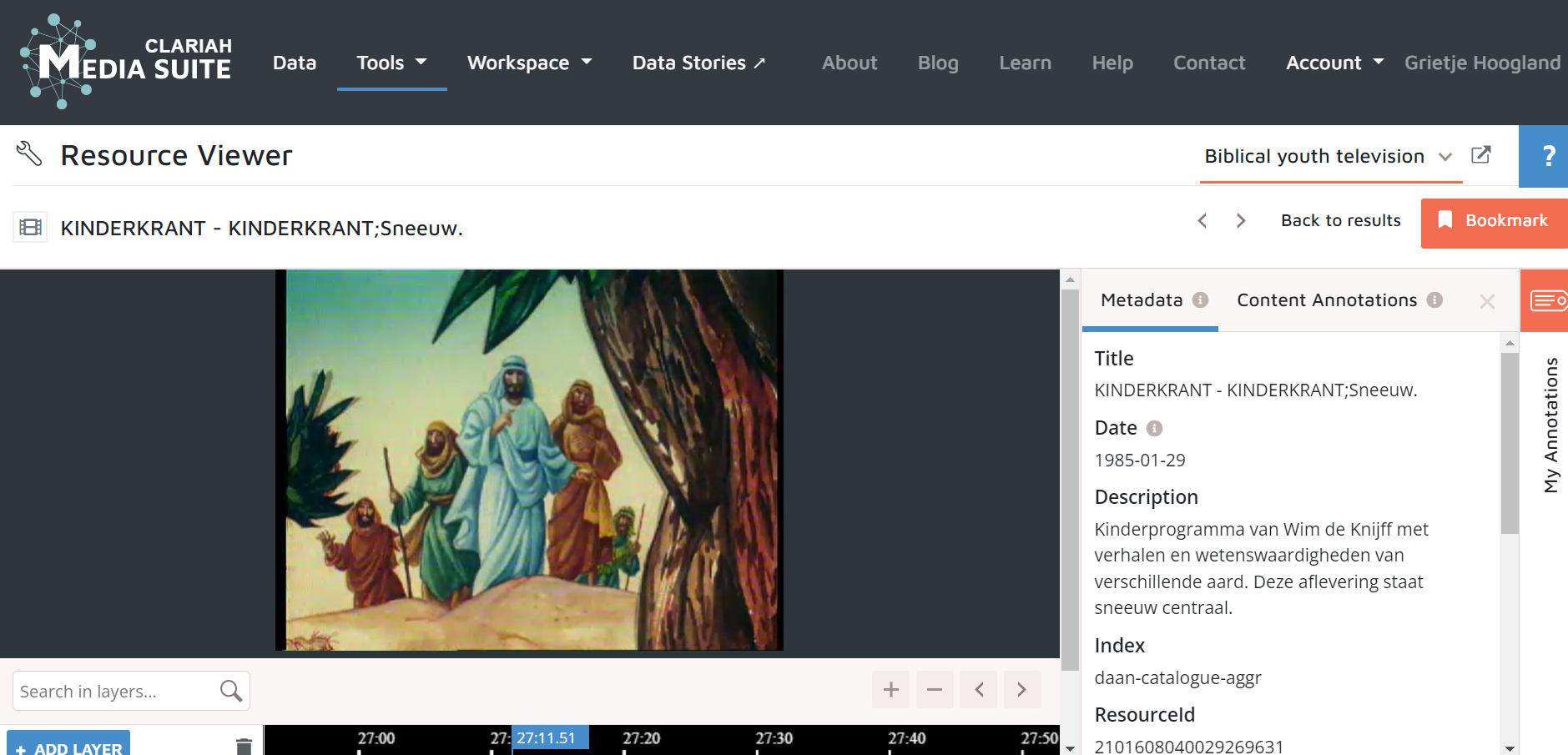
ResourceID: 2101608040029269631, Link to video (login required)
Kinderkrant: Job en z’n pa (EO, 1987)
Another item in Kinderkrant is Job en z’n pa, illustrated in 1987 by NOS illustrator Ton Holst. The stories revolve around a boy who comes to his father for deep conversations about the Bible and religion. Although this is a more progressive approach, the morals in the story and all the explaining by the father still makes it very dense in biblical and missionary content. Holst has an approach that is somewhat unexpected for the evangelical EO. The items are illustrated in a contemporary way, for instance: the dad looks like an ordinary 1980s dad with longer hair and a large moustache. Of course the subject matter made it possible to step away from the traditional depictions of biblical stories a bit more. Holst used layered illustrations for depth and showed attention to detail to give the illustrations a bright and crisp, modern look.
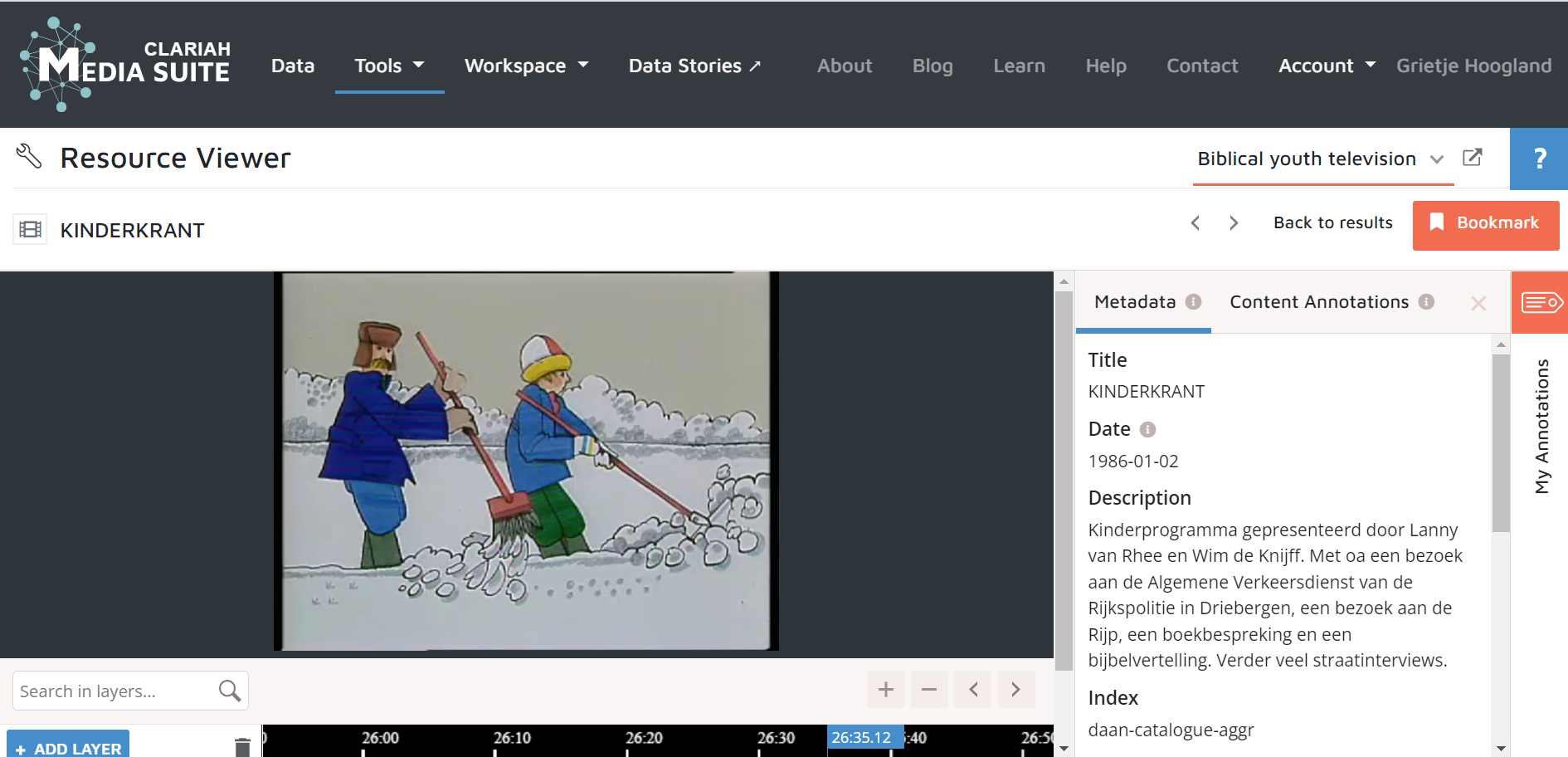
ResourceID: 2101608050039204431, Link to video (login required)
D’r kan nog meer bij (EO, 1983-1989)
Ton Holst also illustrated for D’r kan nog meer bij, another EO program. He uses the same bright style as in Job en z’n pa, although these items were actual stories from the Bible. The stories were read to children in the studio, but in a comprehensible way, so it’s more progressive than the Kinderkrant stories we saw before. In the illustrations by Ton Holst you can see some traditional elements, just enough to help the audience remember what the subject matter is, but he illustrates in a very colourful and contemporary way that resembles Job en z’n Pa more than the biblical stories from Kinderkrant.
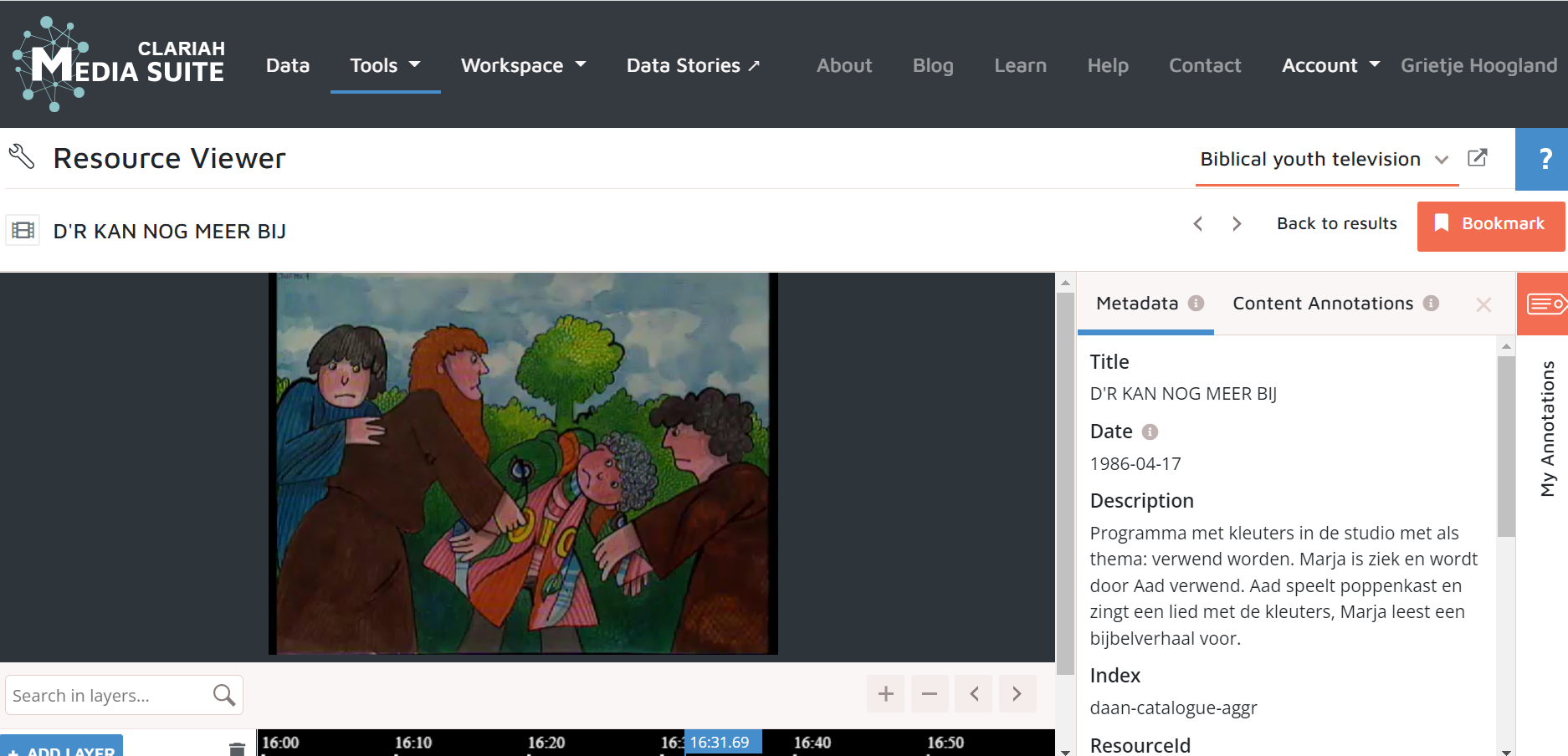
ResourceID: 2101608060045337931, Link to video (login required)
Conclusion and further research suggestions
The two largest religious broadcasting associations KRO and NCRV both quickly realised that their main target audience preferred inspired, but not too directly moralising or missionary content. The smaller IKOR/IKON/CVK/RKK and EO valued this type of content more and therefore showed more traditional content than the KRO and NCRV did. Generally, the content of their programs fit their mission statements: the more traditional or progressive the broadcasting association, the more traditional or progressive the content. The illustrations are most of the time made to fit the content, and are therefore also an indicator of the approach of the directors and more generally the broadcasting associations. Especially the EO clearly shows how difficult it is to deliver the Word of God in a way the audience responds to, without compromising the original biblical texts too much.
These items and programs are all part of my larger research on the history of Dutch illustrated children’s television. It could be interesting to see how these programs developed after 1996, which is where my research stops, especially after the merger of KRO and NCRV in 2016, and the collaboration of IKON with EO from the same year on. This topic could also be extended by adding live action programs, to see if they developed similarly or differently to illustrated programs. Data research on the amount of Biblical programs per broadcasting association or decade could also be an interesting way to get insight into how the Bible is presented to the Dutch television audiences from the beginning of television in the Netherlands to this day.
Footnotes
[1] Christopher G. A. Bryant, “Depillarisation in the Netherlands”, The British Journal of Sociology , Vol. 32, No. 1, 1981 , 56-74
[2] There are no biblical youth programs of VPRO in this list, since the small broadcasting association had not enough airing time for a youth program. Only in the 1980s when the VPRO became a progressive, non-religious broadcasting association, they gained enough members to increase their airing time. At that point they started to make non-religious youth television.
[3] Wijfjes, Omroep in Nederland, Waanders Uitgevers, 1994, 102
[4] Hogenkamp, B., De Leeuw, S., Wijfjes, H., Een eeuw van beeld en geluid, Nederlands Instituut voor Beeld en Geluid, Hilversum, 2012
[5] AVRO Bode, 2-10-1967
[6] https://wiki.beeldengeluid.nl/index.php/KRO
[7] https://wiki.beeldengeluid.nl/index.php/NCRV
[8] https://wiki.beeldengeluid.nl/index.php/EO
References
AVRO Bode, 2-10-1967
Christopher G. A. Bryant, “Depillarisation in the Netherlands”, The British Journal of Sociology , Vol. 32, No. 1, 1981 , 56-74
Hogenkamp, B., De Leeuw, S., Wijfjes, H., Een eeuw van beeld en geluid, Nederlands Instituut voor Beeld en Geluid, Hilversum, 2012
Wijfjes, Omroep in Nederland, Waanders Uitgevers, 1994, 102
https://wiki.beeldengeluid.nl/index.php/KRO
https://wiki.beeldengeluid.nl/index.php/NCRV
https://wiki.beeldengeluid.nl/index.php/EO